Clancy Tucker's Blog, page 237
December 20, 2015
21 December 2015 - THE WONDERFUL IRIS
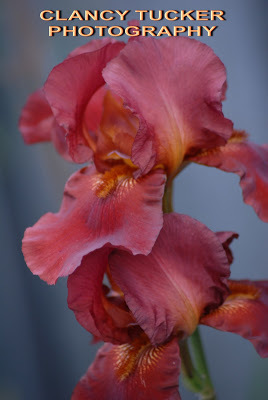
THE WONDERFUL IRIS
G'day folks,
Today, I present some facts on another of my favourite flowers, and include some photographs I took in a mate of mine's garden. Jim Burns is an expert on these flowers. Have a close look at the photographs. I reckon you can see faces.
The tall, beautiful iris, named after the Greek goddess who rode rainbows, comes in many magical colors.
Every gardener wants this perennial.
Despite its divine origins, it is hardy, reliable, and easy to grow. Irises also attract butterflies and hummingbirds and make lovely cut flowers.
There are some 300 species in the genus Iris. The most familiar irises are the tall (at least 28 inches) bearded irises (Iris germanica).
The distinctive flowers have three large outer petals called “falls” and three inner upright petals called “standards.” The falls may have beards or crests. Bearded iris are so-called because they have soft hairs along the center of the falls. In crested iris, the hairs form a comb or ridge.
Most irises flower in early summer. Some, mostly bearded hybrids, are remontant, flowering again later in the summer.
Now, let's check out some of Jimmy's irises.



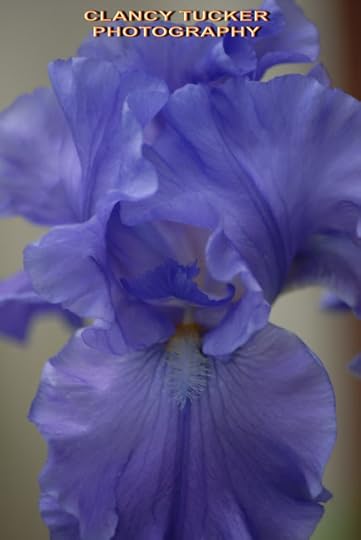



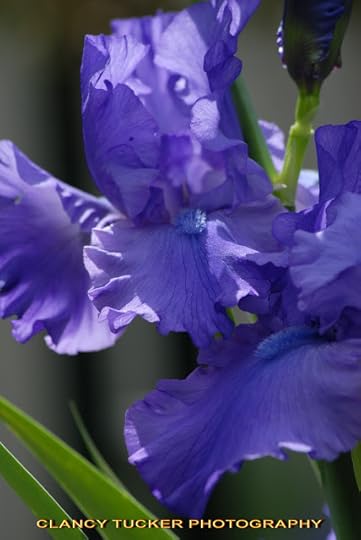

Clancy's comment: Another beautiful lady, eh? Love ya work, Jim Burns.
I'm ...
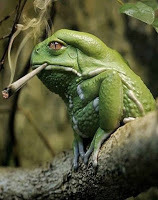

Published on December 20, 2015 01:51
December 19, 2015
20 December 2015 - BYRON BENDING - Guest Illustrator
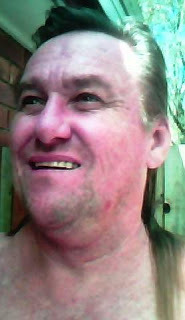
BYRON BENDING - Guest Illustrator -
G'day folks,
Today, I interview an illustrator from Australia. Byron classes himself as a creative, kind, honest person who would love to be, one day, a well known book writer and illustrator of his E- books!
Welcome, Byron ...
1. TELL US A LITTLE ABOUT YOURSELF AND YOUR ILLUSTRATING JOURNEY.I was born and raised in the Solomon Islands, off Papua New Guinea, and started doing Art and design at High school.
2. WERE YOU GOOD AT DRAWING AS A KID?I loved to doodle in class, drawing motorbikes, Bands, animals.
3. WHEN AND HOW DID YOU BECOME AN ILLUSTRATOR?When I moved to Brisbane, Australia. I did an art course and screen printing, selling my t-shirt designs at markets.
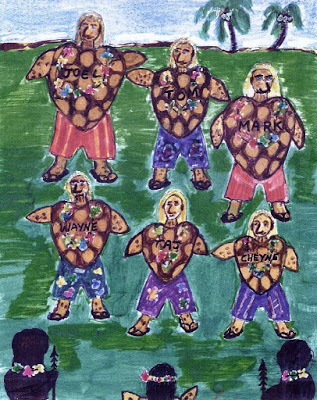
WHAT DO YOU ENJOY MOST ABOUT BEING AN ILLUSTRATOR?I love creating the idea and watching it grow!
4. WHAT IS THE HARDEST THING ABOUT BEING AN ILLUSTRATOR?Patience and brainstorming.
5. DO YOU WORK FOR YOURSELF, OTHERS OR BOTH?I have in the past, but now do it from home.
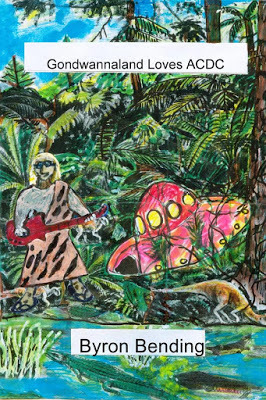
6. WHAT WERE YOU IN A PAST LIFE, BEFORE YOU BECAME AN ILLUSTRATOR?Painter
7. WHAT IS YOUR GREATEST ACHIEVEMENT?Having two children
8. WHAT ARE YOU WORKING ON AT THE MOMENT?A animation video, about stopping Animal Cruelty.
9. WHAT IS YOUR FAVOURITE MEDIUM?Water paints and pen.
10. WHAT INSPIRES YOU?Movies, Australian culture, animals, marine life.
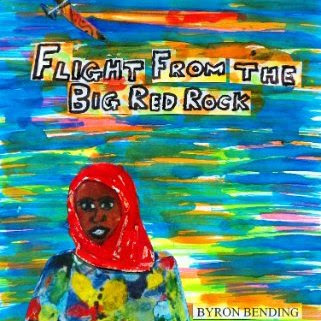
11. WHAT DO YOU PREFER TO ILLUSTRATE?Marine scenes and the outback.
12. DO YOU HAVE ANY TIPS FOR EMERGING ILLUSTRATORS?Don't stop trying to get better!
13. DO YOU SUFFER FROM ILLUSTRATOR’S BLOCK?Sometimes!
14. DO YOU HAVE A PREFERRED SCHEDULE?Yes, mainly early and late in the day!
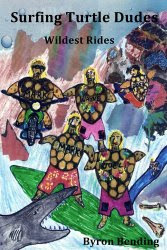
15. DO YOU HAVE A FAVOURITE PLACE TO ILLUSTRATE?In my lounge room! Watching TV.
16. WHAT IS YOUR GREATEST JOY IN YOUR WORK?Seeing the finished work!
17. WHO IS YOUR FAVOURITE ILLUSTRATOR AND WHY?It was L.Devinci! Because he came up with original ideas!
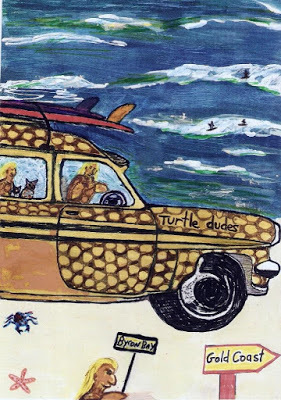
18. WHAT’S THE GREATEST COMPLIMENT YOU EVER RECEIVED?My brother telling me I have a gift for Art.
19. WHAT WAS THE WORST COMMENT YOU EVER RECEIVED?The idea is bizarre
20. WRITERS ARE SOMETIMES INFLUENCED BY THINGS THAT HAPPEN IN THEIR OWN LIVES. ARE YOU?Yes.
21. HOW MANY BOOKS HAVE YOU ILLUSTRATED?About 20.
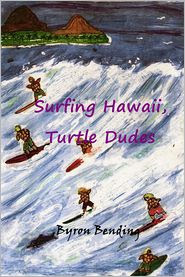
22. HAVE YOU WON ANY PRIZES OR AWARDS?No, not yet!!
23. WHAT DID THEY MEAN TO YOU? Ask me after I win one!
DRAWING, WHAT ELSE DO YOU LOVE?Sport, animals, culture.
24. WHAT WOULD YOU SAY TO ALL WORLD LEADERS IF YOU HAD THE OPPORTUNITY?Stop abusing our planet and stop wars!
25. DESCRIBE YOUR PERFECT DAY.Going fishing on a summer day!
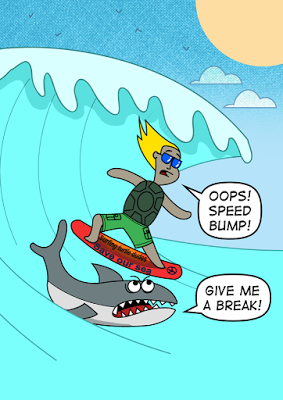
26. WHAT ARE YOUR PLANS FOR THE FUTURE?Keep doing what I do now!
27. HAVE YOU MET SOME GREAT PEOPLE ALONG THE WAY?Great as in their person, yes! but not famous great!!
28. ANYTHING YOU’D LIKE TO ADD?Love Jesus and thank him every day for helping me!!

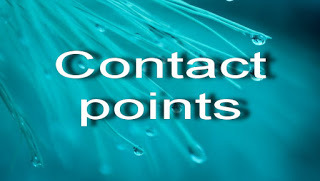
AMAZON

Clancy's comment: Go, Byron. Sounds like you have heaps of fun doing what you do. Good for you. Way to go.
I'm ...


Published on December 19, 2015 03:08
December 18, 2015
19 December 2015 - BACKGROUND BEHIND ALICE IN WONDERLAND
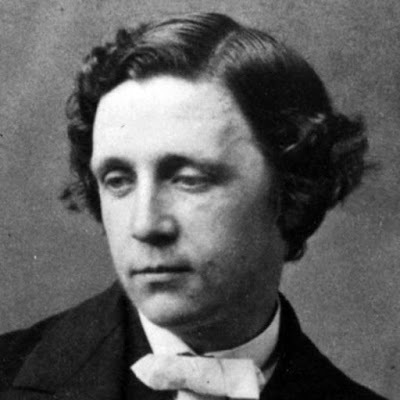
BACKGROUND BEHINDALICE IN WONDERLAND
G'day folks,
Some books stand out from the rest, and Alice In Wonderland seems to be one of those. Here is some background about this book and its author. It's quite a long post, but very detailed, and you might find it interesting
Some books are products of their time – and remain there. Popular for a short period, they fade away as the years go by, only remembered by the occasional literary researcher. Other books are more fortunate. They become what we call “timeless” – they seem to exist outside of time, as if they had always been there and always would be. For these books, the passage of time diminishes neither their visibility nor their impact. They are books so culturally vital that not only do they never go out of print, but they also grow in popularity through critical and academic attention. They are the books that form or, in some cases, remake our culture.
Lewis Carroll’s Alice’s Adventures in Wonderlandis one of these influential books. Not only is it one of the most beloved books in the history of literature, but it is also one of the most fervently studied. Just this year, Martin Gardner’s exhaustive The Annotated Alice has been reissued and expanded, and a new study by Victorian-era scholar Robert Douglas-Fairhurst, The Story of Alice: Lewis Carroll and the Secret History of Wonderland, has added further weight to the Alice bookshelves. These books testify to the continuing relevance of a book that is now a century and a half old.
It isn’t difficult to understand the perpetual appeal of Alice’s Adventures in Wonderland. Its unique combination of wild fantasy, subversive humor, and clever play with logic and language make it an almost inexhaustible source of the best kind of nonsensical fun. But, undeniable as the book’s entertainment value may be, within and underneath the nonsense there is also a rich seam of ideas that reward deeper exploration. The book continues to live because it’s both highly entertaining and ripe with ideas, equally at home in a nursery as it is in a university course.

Where did this book come from and why does it exist? How did it get published and what was its effect, then and now? Today Bio presents the biography of a book, one that has transformed the imaginative lives of innumerable children, and through them, the world they have grown up to inhabit.
Alice Meets the Professor
Like the character of Alice herself, Lewis Carroll was a fiction based on a real person. His real name was Charles Lutwedge Dodgson, his pen name having been chosen as a Latin play on his first and middle names (“Charles” became “Carolus” became “Carroll”; “Lutwidge” became “Ludovicus” became “Lewis”). Pen names were common enough in Victorian England, but they were especially useful to men of certain position who wanted to moonlight at other work. Dodgson was an Anglican cleric and math professor at Oxford University whose serious publications included A Syllabus of Plane Algebraic Geometry and the snappily titled An Elementary Treatise on Determinants, with Their Application to Simultaneous Linear Equations and Algebraic Equations. There was no place for white rabbits and mad hatters in books like these.
His “serious” work aside, Carroll’s taste for whimsy had long been in evidence. He had been penning verse and prose for his own enjoyment since he was a child. A great number of these literary efforts were comical in tone, often turning traditional forms on their heads to make a joke or pull off a pun. It was a hobby, much like his love of a new technology that also grabbed his interest: photography. At the time, taking and developing a photograph was a laborious process, but the discipline and precision required to create a print suited Carroll’s personality perfectly.
At Oxford, Carroll's interest in photography became well known, and other professors and their families were often his subjects. One of these was the new Dean of Oxford, Henry George Liddell, who became dean the same year that Carroll received his permanent appointment as math lecturer, 1855. Carroll became a frequent visitor to the Dean’s home and a family friend to the dean’s wife and their four children. One of those children would come to play the key role in Carroll’s life – her name, of course, was Alice, and she stood out from her brother and two sisters by virtue of her humorous personality and active imagination.
Carroll, a childless bachelor, enjoyed the company of Alice and the other Liddell children, and he often used them as subjects for his photographs. He would entertain them with games and tell them stories. Like many Victorians, Carroll possessed a sentimental view of children as heavenly innocents who were closer to the divine than adults, but although his photographs often idealized them, his stories were usually more down-to-earth. Often, they upended the standard morality tales that were the largest share of a child’s literary diet in the mid-19th century, turning them nonsensical. The Liddell children thoroughly enjoyed visits from the ever-creative and ever-attentive Carroll, who was so unlike their own stern and taciturn father.
Alice Goes Underground On July 4, 1862, Carroll, a colleague, and the Liddell sisters took a boat excursion up the Thames to go on a picnic – not an unusual occurrence. Carroll liked to go boating and rowing, and he often did so with Harry, Alice’s brother, or with a larger group of the siblings. As he did on land, Carroll liked to entertain his young charges on such trips with stories that he would improvise as he went along. On this day, however, he decided to try out a new story into which he’d made 10-year-old Alice a central figure. It was about a girl (named Alice, naturally) who goes down a rabbit hole and has many adventures underground, few of which obey any logical aboveground rules. Carroll spent much of the trip spinning his yarn, all the way up the river and even at the picnic spot once they arrived. By all accounts, the story delighted its audience with its outrageous developments and ever more surreal episodes.

Carroll’s improvisations on this day must have been particularly inventive; the next day, still buzzing about the story, Alice Liddell urged him to commit it to paper for her. Carroll wasn’t sure he could recreate his spontaneous story, but since Alice was so insistent that he try, he began to write down what he could remember. Putting it in writing naturally reshaped the tale, but it still retained its shaggy-dog, improvisatory character.
Getting it down didn’t come easy, however; it took Carroll months to produce even a preliminary version. The story also kept taking new forms and moving in new directions as the Liddell children would ask him to continue the tale on his frequent visits to their home.
These visits became abruptly less frequent after a visit in June of 1863. The reason is unclear; Carroll’s personal diaries are missing pages, possibly removed by relatives after his death, and the Liddell family remained mum on the topic throughout their lives. Some researchers speculate that Carroll formally asked for the hand of Alice or Ina Liddell, after which he was rebuffed by Dean Liddell (in 1860s England, a girl of 12 was considered old enough to consent to marriage, so such a request would not be unheard of, but Carroll would not have been an especially appealing prospect to a family of the Liddells’ station). Other speculations include that Carroll made some attempt to move beyond the bounds of friendship with Alice or her sister; that Carroll had inappropriately approached the girls’ chaperone, a woman named Ms. Pickett; or that Carroll had simply offended Mrs. Liddell with a gift he’d given Alice, a book about three girls who need a man to take care of them after their mother dies.
Whatever the true reason for the sudden break, Carroll ceased to visit the Liddells for more than a year afterwards and met them in public very infrequently. He continued to work on his handwritten manuscript, however, even decorating the pages with his own sketches. By mid-1864, he had completed the first version of the tale, which he called Alice’s Adventures Under Ground. He had it bound, and on November 26, 1864, he dispatched it to Alice Liddell as an early Christmas gift with the inscription “A Christmas Gift to a Dear Child in Memory of a Summer Day.” Alice was proud of the gift and shared it with visitors. Carroll, meanwhile, was happy that he had fulfilled his promise to her and realized his initial ambition for the story. Already, however, he began to see a potential in the tale far beyond the modest intentions behind its creation.
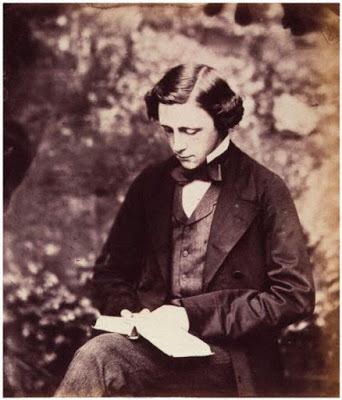
Alice Gets a Makeover Through an Oxford connection, Carroll met with Alexander Macmillan, whose publishing firm had become a highly respected house for writers in its 20 years of existence. Macmillan agreed to publish a more developed version of the Alice story after seeing a completed chapter, which Carroll had put together at the same time as he was working on Alice’s Adventures Under Ground. Carroll agreed to underwrite the production costs of the book as long as he could maintain full control over the project.
Soon, Carroll was working to improve and expand his original work. There were more puns and games, added characters (including The Mad Hatter and his tea party), and invented language (Carroll coined words like beamish and chortle that later became genuine English words). Perhaps most importantly, Carroll realized that his illustrations were not professional enough for a published version of the tale. Impressed by the work of Punch artist John Tenniel, Carroll convinced him to join the project. In some ways, Carroll regretted his decision – Tenniel was as much of a perfectionist as he was, and he slowed down the progress of the book considerably. Carroll had to admit when he saw the artist’s work, however, that his illustrations added a striking new dimension to the book. They were as distinctive in their way as Carroll’s text.
In mid-1865, over a year after Carroll had commissioned Tenniel to create art for his project, and after many proofs had been corrected and revised, Alice’s Adventures in Wonderlandwas complete. Carroll was delighted to hold a copy of the finished book in his hand that July, but Tenniel wrote him to say that he was unhappy with the print quality of his pictures. Carroll reluctantly asked Macmillan not to distribute the 2,000 copies that comprised the first run of the book, and at his own expense, he had the book reset and reprinted by a different printer. Tenniel was satisfied with this version, and Carroll agreed that it was superior: “a perfect piece of artistic printing,” in his own words. In November of 1865, Alice’s Adventures in Wonderlandhit the bookstores in time for the holidays.
By this time, Carroll had already sent a specially bound and printed version of the book to Alice Liddell. He made sure that it was delivered on July 4, the day of the boat trip that inspired the tale. Carroll never lost sight of the fact that Alice was the inspiration for his book. As he wrote in a letter to her mother, Alice was the person “without whose infant patronage I might possibly never have written at all.”
Alice Enters (and Conquers) the World Alice’s Adventures in Wonderland was the Harry Potter of its day. Its second run sold out quickly, and the book was reprinted multiple times within its first couple of years on the market. Carroll recouped his losses on the first, unused printing by deciding to sell most of the copies to an American publisher, D. Appleton & Co. (the remaining copies were donated to a children’s hospital near Oxford). Thus, in April of 1866, the book began to be sold in the U.S., and as far as we know, no one complained about the print quality. On the contrary, it proved almost as popular here as it had in its homeland. In the next few years, the book would spread further across the globe once it was translated into French, German, and Swedish (Carroll himself supervised several of these translations, which proved tricky with a book so concerned with wordplay).
Lewis Carroll became a respected and recognized name almost overnight. Although he had ambivalent feelings about the attention that came his way, Carroll couldn’t deny that success had its benefits, including a move to nicer rooms on campus with a state-of-the-art photography studio added on, which provided more opportunities to photograph new acquaintances. One of these was Lord Salisbury, Chancellor of Oxford, who would later become Prime Minister of England. Carroll also sent copies of the book to people he was interested in meeting, including other writers and statesmen. He even sent a copy to the Queen’s daughter with his compliments.
Carroll did not rest on his laurels, however. In much the same way that the success of the first Harry Potter book resulted in a sequel soon afterwards, the success of Alice’s Adventures in Wonderland prompted Carroll to consider a sequel to his own hit book. He saw many possibilities for further adventures, some of which he already had written, and he was in negotiations with Macmillan by the end of the summer for a new Alice book. He began to assemble a new manuscript, although his other activities caused it to develop slowly. By early 1868, he was ready to ask Tenniel if he would be willing to create illustrations for the new Alice book. Although initially reluctant, Tenniel finally agreed by the summer. By Christmastime 1871, better late than never, the sequel finally emerged: Through the Looking-Glass, and What Alice Found There. An immediate hit, it sold even more quickly than its predecessor had.
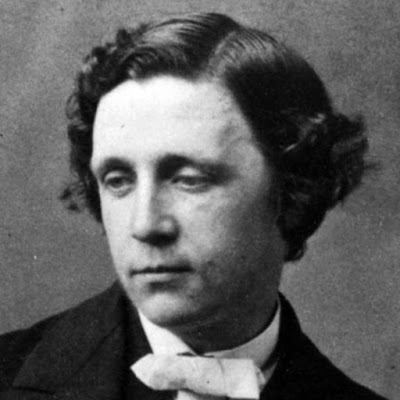
The impact of Alice’s Adventures in Wonderland and Through the Looking-Glass on children’s literature was immense. If imitation is the highest form of flattery, then Carroll was the most flattered man in England. Books full of wonderland-style environments, books based on dreams, and books based on nonsense all flooded the market. Children’s literature, too long the province of writers more concerned with moralizing than with engaging their young readers, flowered into a genre of greater variety and imagination. Even adult non-fiction began to resonate with the effects of Alice. So widespread was the concept of a “wonderland” that soon the word began to be applied to actual places rather than imaginary landscapes.
Alice cast a long shadow, and for the rest of his life, Carroll would be known primarily for his Alicebooks. He took the legacy seriously, and created variations of his book to meet different needs, such as The Nursery “Alice,” a simplified version for very young readers that he issued in 1890. Although he would write other works of poetry and prose, some rather eccentric, Carroll never again reached as large of an audience. At times, he would chafe at the hold the Alicebooks maintained on his career, but mostly he was proud. He approved stage versions, and even contributed ideas to a couple of them. He even published a reproduction of the original version of the story that he had handwritten for Alice Liddell in 1886 so that fans could see the book in its original form. (Alice Liddell still possessed this original version and would hold onto it until a few years before her death. Today it resides in the British Museum.)
When Carroll published the facsimile of Alice’s Adventures Under Ground, Alice Liddell became more widely recognized as the inspiration for the creation of Wonderland. She would carry this notoriety for the rest of her life, even after a society marriage and three children (two of whom were killed in World War I). Just as being Alice’s “father” sometimes irked Carroll, the strain of being “the real Alice” could sometimes be wearisome for Alice Liddell, now Alice Hargreaves. Late in life she wrote to her son, “Oh, my dear I am tired of being Alice in Wonderland! Doesn’t it sound ungrateful & is– only I do get tired.” As much as a respectable upper class lady could, however, she remained a booster for Carroll and the books until her death in 1934, even taking part in a Carroll centenary celebration in New York in 1932.
After Carroll’s death in 1898 and the expiry of the copyright on the original book in 1907, the floodgates opened and new sequels appeared by other writers, as well as new editions with pictures by different artists. Since 1907, over 150 artists have done interpretations of the Alice books; even Salvador Dalidid one. This proliferation of editions ensured that the story was constantly before the public, as did cheaper editions approved by Carroll when he was still alive. For the first time, these editions brought the story to families who couldn’t afford to purchase expensive hardbound books.
Another important reason for Alice’s longevity had to do with technological innovations in entertainment. Alice had already graduated to the stage by the late 19th century, but at the dawn of the 20th, the advent of the moving picture created an entirely new arena for the Alice phenomenon to take hold. As early as 1903, a version of Alice’s Adventures in Wonderland, retitled Alice in Wonderland, had appeared in England. Edwin S. Porter,the man who directed The Great Train Robbery, adapted the story in the U.S. for the first time in 1910. Dozens of versions followed, most famously Walt Disney’s animated version from 1951. Variations on the story continue to appear in cinemas in this century, the most high-profile film of recent years being the revisionist Alice in Wonderland from 2010 starring Johnny Depp, Helena Bonham Carter, and Mia Wasikowska. A sequel to this film, Alice Through the Looking Glass, is in production and due to be released next May. The characters created by Lewis Carroll continue to fascinate.
Since his death, many biographies of Lewis Carroll have appeared, some more favorable than others. Contemporary writers sometimes look with a jaundiced eye at Carroll’s private life, particularly his interest in photographing children, and pronounce judgment. Judging Victorian culture by modern standards can be precarious, however, and speculating about questionable behavior in the absence of solid evidence can be unfairly damning. Perhaps it’s only natural that readers want to know more about the motivations of a man who created a book that features, and was written for, a young girl, but these readers may be losing sight of the key point – the book itself, which has grown so far beyond the circumstances of its creation, continues to delight and fire the imaginations of generations of children, long after its author ceased to be. A tale created to please one child has gone on to fascinate millions. A man is not timeless, but his work can be, and that is the case with Alice’s Adventures in Wonderland– a book that will live as long as children (and adults) enjoy it on its own terms, irrespective of the ebb and flow of its creator’s reputation.

Clancy's comment: Amazing that we are still talking about it today. Hope they are still reading my books well after I'm gone.
I'm ...
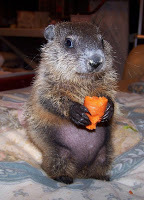

Published on December 18, 2015 01:35
December 17, 2015
18 December 2015 - Maya Lin’s Vietnam Veterans Memorial
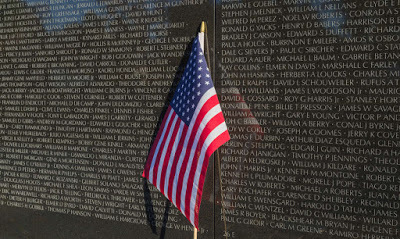
Maya Lin’s Vietnam Veterans MemorialG'day folks,Tonight, I will be guest speaker at a Vietnam Veteran's organisation here in Australia, so I thought it timely to present something relevant.
As the United States honors those who served in the military on Veterans Day, read the story of how an unknown 21-year-old architecture student, Maya Lin, designed one of the most moving monuments in the nation’s capital—the Vietnam Veterans Memorial.
Whenever 18-year-old Maya Linwalked through Yale University’s Memorial Rotunda, she couldn’t resist passing her fingers over the marble walls engraved with the names of those alumni who died in service of their country. Throughout her freshman and sophomore years, she watched as stonecutters added to the honor roll by etching the names of those killed in the Vietnam War. “I think it left a lasting impression on me,” Lin wrote, “the sense of the power of a name.”
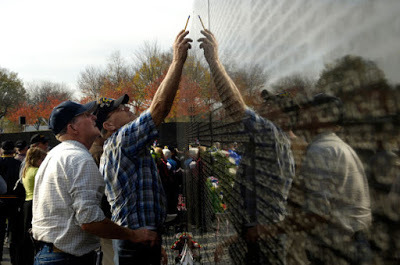
Those memories were fresh in the mind of the daughter of Chinese immigrants senior year when, as part of an assignment in her funereal architecture seminar, she designed a walled monument to veterans of the Vietnam War that was etched with the names of those who gave their lives. Encouraged by her professor, the architecture student entered it in the national design competition being held for the Vietnam Veterans Memorial to be built on the National Mall in Washington, D.C.
Adhering to the competition rules that required the memorial to be apolitical and contain the names of all those confirmed dead and missing in action in the Vietnam War, Lin’s design called for the names of nearly 58,000 American servicemen, listed in chronological order of their loss, to be etched in a V-shaped wall of polished black granite sunken into the ground.
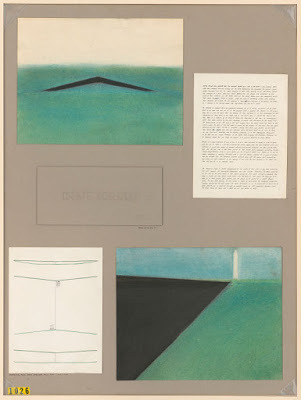
The competition garnered more than 1,400 submissions, so many that an Air Force hangar was called into service to display all the entries for the judging. Since all submissions were anonymous, the eight-member jury made its selection based solely on the quality of the designs. It ultimately chose entry number 1026, which it found to be “an eloquent place where the simple meeting of earth, sky and remembered names contains messages for all.”
Her design only earned a B in her class at Yale, so Lin was shocked when competition officials came to her dormitory room in May 1981 and informed the 21-year-old that she had won the design and the $20,000 first prize. Not only was Lin not a trained architect, she didn’t even have a bachelor’s degree in architecture at the time. “From the very beginning I often wondered, if it had not been an anonymous entry 1026 but rather an entry by Maya Lin, would I have been selected?” she later wrote.

Although she designed an apolitical monument, the politics of the Vietnam War could not be avoided. Like the war itself, the monument proved controversial. Veterans groups decried the lack of patriotic or heroic symbols often seen on war memorials and complained that it seemingly honored only the fallen and not the living veterans. Some argued that the memorial should rise from the ground and not sink into the earth as if it was something to be hidden. Businessman H. Ross Perot, who had pledged $160,000 to help run the competition, called it a “trench” and withdrew his support. Vietnam veteran Tom Cathcart was among those objecting to the memorial’s black hue, which he said was “the universal color of shame and sorrow and degradation.” Other critics thought Lin’s V-shaped design was a subliminal anti-war message that imitated the two-finger peace sign flashed by Vietnam War protestors.
“One needs no artistic education to see this memorial design for what it is,” remarked one critic, “a black scar, in a hole, hidden as if out of shame.” In a letter to President Ronald Reagan,27 Republican congressmen called it “a political statement of shame and dishonor.”
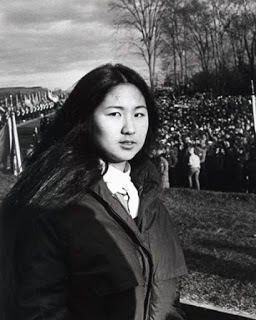
Secretary of the Interior James Watt, who administered the site, sided with the critics and blocked the project until changes were made. Over Lin’s objection, the federal Commission of Fine Arts bowed to political pressure and approved the addition to the memorial of a 50-foot-high flagpole on which to fly the Stars and Stripes and an eight-foot-high statue of three soldiers sculpted by Frederick Hart, who called Lin’s design “nihilistic.” The commission, however, mandated that they not be placed directly adjacent to the wall in order to preserve Lin’s design intent as much as possible. (A statue dedicated to the women who served in the Vietnam War was also added to the site in 1993.)
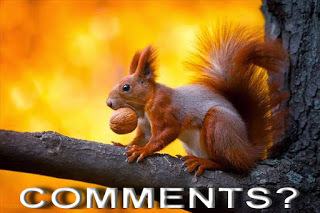
Clancy's comment: Mm ... Lest we forget those who died, and especially those who survived but still suffer.
I'm ...
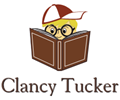
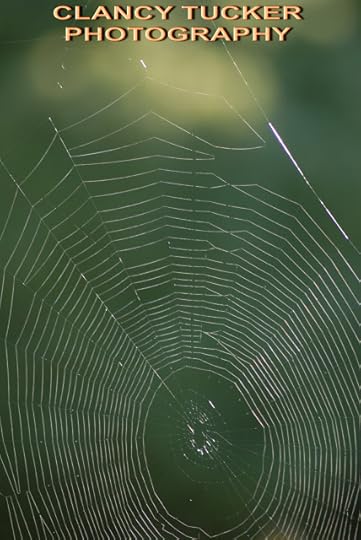
Published on December 17, 2015 01:55
December 16, 2015
17 December 2015 - QUOTES FROM TOP WRITERS
QUOTES FROM TOP WRITERS
G'day folks,
Here are some more quotes from great authors. Hope they inspire you to keep going.

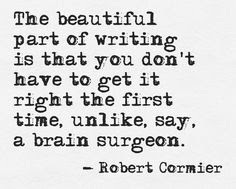
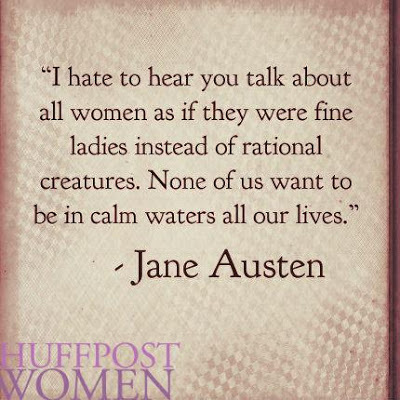
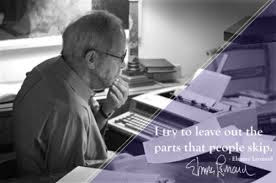
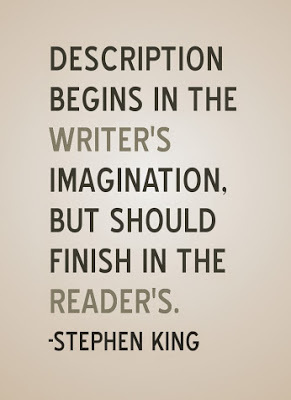
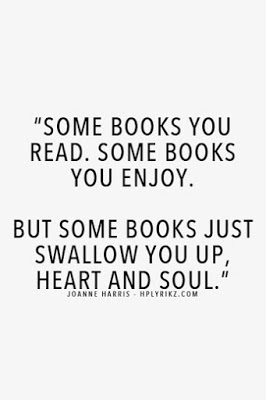


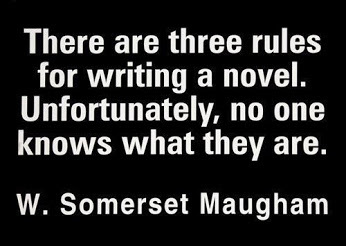
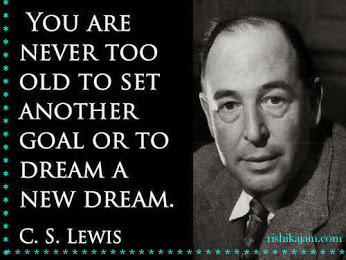

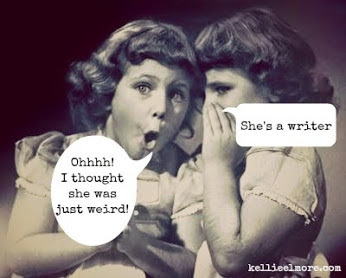
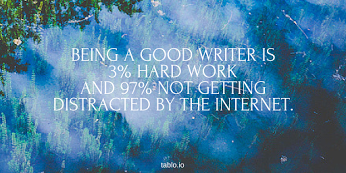


Clancy's comment: I hope these fired you up.
I'm ...

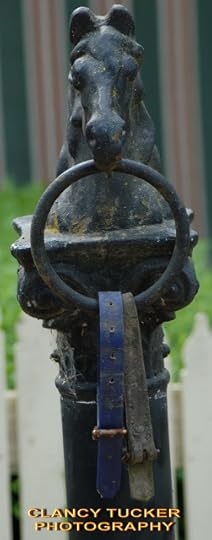
Published on December 16, 2015 02:31
December 15, 2015
16 December 2015 - WHY PEOPLE KISS THE BLARNEY STONE
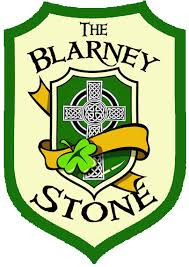
WHY PEOPLE KISS THE BLARNEY STONE
G'day folks,
The Blarney Stone is a block of Carboniferous limestone built into the battlements of Blarney Castle, Blarney, about 8 kilometres from Cork, Ireland. According to legend, kissing the stone endows the kisser with the gift of the gab.
Kissing Ireland’s Blarney Stone, a tradition that’s been around for several centuries, is said to give a person the gift of eloquence and persuasiveness. The iconic stone is set in a wall of Blarney Castle, constructed in 1446 by Dermot McCarthy, king of Munster, on the site of a demolished 13th century castle.
Various legends surround the Blarney Stone’s origins. One story holds it was acquired during the Crusades and brought to Ireland, while another tale claims it was made from the same material used at Stonehenge. An additional account links it to the Stone of Scone (also called the Stone of Destiny), which was used for hundreds of years in the coronation of Scottish and English monarchs, while yet another legend contends it was a gift from Robert the Bruce, king of Scots, to Cormac McCarthy, king of Munster, for sending men to help Bruce defeat the English at the Battle of Bannockburn in 1314.
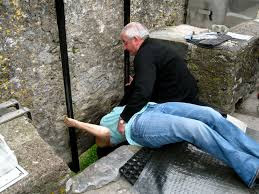
However, in 2014, geologists from the University of Glasgow shed some light on the Blarney Stone’s heritage when they concluded that the famous rock isn’t from Scotland but instead is made of 330-million-year-old limestone local to the south of Ireland.
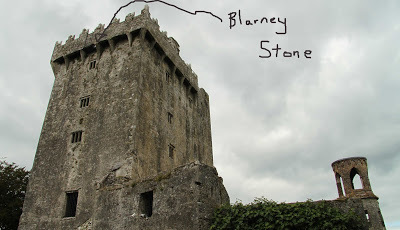
The word “blarney,” meaning skillful flattery or nonsense, supposedly came into use following an incident involving the head of the McCarthy family and Queen Elizabeth I, who ruled England and Ireland from 1558 to 1603. The queen sent the earl of Leicester to seize Blarney Castle but the talkative McCarthy managed to keep stalling him. The queen grew exasperated by the earl’s reports about the lack of progress in the matter and uttered something to the effect that the reports were all “Blarney.”
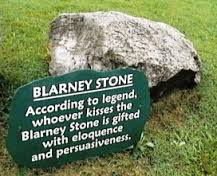
Today, people travel from around the globe to give the Blarney Stone a peck (which must be done by leaning backward while holding onto two railings). Winston Churchill is among the notable figures who’ve kissed the stone, doing so in 1912 when he was First Lord of the Admiralty. Who’s to say that smooch didn’t bestow a little eloquence on Churchill, who went on to become British prime minister in 1940 and earn a reputation as a masterful orator?
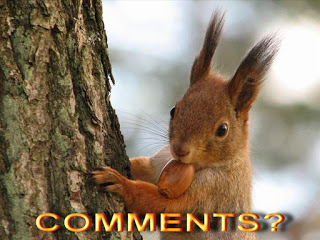
Clancy's comment: One can only assume that all politicians have been there and done that.
I'm ...

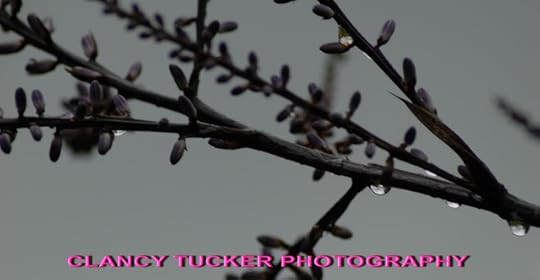
Published on December 15, 2015 01:46
December 14, 2015
15 December 2015 - Dr JERI FINK - Guest Author and Photographer
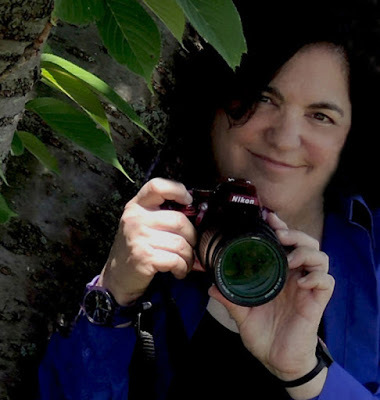
Dr. JERI FINK
- Guest Author& Photographer -
G'day folks,
Today, I interview someone who shares my love of writing and photography.
Dr. Jeri Fink re-invented the art of storytelling, merging fiction, fact, and photo insights into riveting books you'll never forget. Find her work as a Family Therapist, expertise in psychopaths, and photography in her 27 books and hundreds of articles and blogs. Read her BROKEN series of thrillers; subscribe to photo insights; and enjoy fascinating blogs on www.hauntedfamilytrees.com
Welcome, Jeri ....
1. TELL US A LITTLE ABOUT YOURSELF AND YOUR WRITING JOURNEY.
Writing is in my soul. I wouldn’t know how not to write.
2. WHEN AND HOW DID YOU BECOME A WRITER?
I was eight years old. I had one of those black-and-white marbled composition books. Instead of using it for schoolwork, I began to write stories about people and animals. I grew up in New York City, so I would sit on a bus or subway looking at people and making up stories about them.
That hasn’t changed J
3. WHAT TYPE OF PREPARATION DO YOU DO FOR A MANUSCRIPT? DO YOU PLAN EVERYTHING FIRST OR JUST SHOOT FROM THE HIP?
I never have a shortage of ideas. When I start a new manuscript, I have to choose which idea to follow. It’s not difficult – in fact, often I have to consciously push away my “ideas” into a file in my head so I can focus on only one or two at a time.
Preparation, of course, depends on my genre. Blogs, articles, mini books, and other short pieces require a statement of my subject and an outline. Then I research. I’m an intense researcher – I won’t accept a “fact” until I’ve seen it at least three times in publications (websites) I know I can trust. Even then, I make sure there is no conflicting information. I also outline my fiction but in a different way. For example, my 7-book series of thrillers are all connected, over 500 years, so I have book outlines, timelines, character connections, names, etc.
I’m always surprised when I hear that a writer doesn’t like research. I LOVE research. My favourite type of research is to gather the information and then go to the location. I bring my camera, my notes, and a lot of blank pages. My new thriller series came together that way.
BTW I usually do my first drafts longhand and then transfer them to the computer where I edit (as I’m transferring them) and edit/rewrite five or six times or more.

4. WHAT DO YOU ENJOY MOST ABOUT BEING A WRITER?
Everything but the business! I love the research, writing, integrating photographs and words, stories . . . I could go on forever. Over the years I’ve come up with several new terms that were not defined at the time. One of them is psychotechnology – the psychology of technology. More recently, is photo insights – the merging of words and photographs to deepen the reading experience. Photo insights, by definition, are a reflection of photo psychology (a concept I did not invent).
In my series of thrillers, I’ve done extensive research on psychopaths and the psychopathic spectrum, drawing from my own experiences as a Family Therapist/Social Worker, professional literature, interviews, popular literature, statistics, videos . . . I love to move between different media to create a fully integrated concept.
5. WHAT IS THE HARDEST THING ABOUT BEING A WRITER?
That’s easy – THE BUSINESS. I have no trouble writing books, blogs, articles, and creating photo insights. It’s a lot easier than marketing, promotion, publicity, and branding.
6. WHAT IS YOUR GREATEST WRITING ACHIEVEMENT?
Someone once asked me which was my favorite book. After writing and publishing 27 books (I’m a hybrid author – I publish both traditional and indie), hundreds of blogs, articles, and photo essays, my answer is – the piece I’m working on at the moment.

7. WHAT ARE YOU WORKING ON AT THE MOMENT?
I’m completing a 7-book series of thrillers, Broken, that merge fiction with photo insights, and explore psychopaths and their prey. As a family therapist, I’ve had a lot of experience with this . . . The first three books are out on Amazon; I hope to complete the final four books before the end of this year. I also write several blogs, run a photo psychology email list, and post regular photos on Instagram, Facebook, Twitter, etc.
8. WHAT INSPIRES YOU?
Life. Inside, I’m still that child who looks and hears stories everywhere. In fact, I think and dream in stories. Some people have auditory memories; others visual memories. I have a memory based on stories – I might not remember your name but I won’t forget your story.
9. WHAT GENRE DO YOU WRITE?
Whatever works for what I’m writing at the moment. My blogs and articles are all nonfiction. Broken consists of fictional thrillers that incorporate historical facts, actual people and places, and of course, photo insights. I’ve written children and adult books, professional books, fiction and nonfiction. My mini-books are nonfiction.
10. DO YOU HAVE ANY TIPS FOR NEW WRITERS?
READ! Too many new writers ignore the fact that part of being a writer is being a reader. Then WRITE! Write, edit, and rewrite . . . sweat over your work. Enjoy that part of it as much as the original creation.
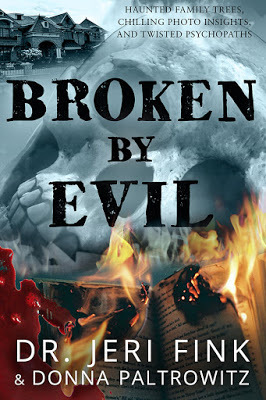
11. DO YOU SUFFER FROM WRITER’S BLOCK?
Never. If I can’t think of a solution or story, I just go to sleep and dream it. That works every time. I’m a lucid dreamer.
12. DO YOU HAVE A PREFERRED WRITING SCHEDULE?
I prefer to write fiction in the morning. The creative words flow easier at that time of day. Nonfiction tends to be better later in the day or evening. Editing/rewriting is best midday. However, I can write any time of day (and do). I love late at night (early morning) to work – well after midnight – because the world around me is quiet and peaceful and the noise in my head has a better chance to be heard. J
13. DO YOU HAVE A FAVOURITE WRITING PLACE?
My desktop computer is in my home office. The kitchen table, along with a lot of ice cream and chocolate chip cookies works very well too. My dogs keep me and my characters company.
14. WHO IS YOUR FAVOURITE AUTHOR AND WHY?
I’ve been asked that question so many times! It’s like asking what my favourite flower is – my favourite ice cream – even my favourite restaurant. There are so many good authors out there that I tend to say my favourite is the one I’m reading at the present. If you want to go back in time, I would say Mark Twain because of his humour, his colourful characters, and the common sense he imparts. I love Shakespeare, although it’s much better to see his work performed rather than read it. How can I leave out Colleen McCullough, James Michener, and Michael Crichton? I’m a big fan of Greg Iles, Naomi Regan, and Noah Gordon . . . the list goes on. Right now (since I recently returned from the Arctic), I’m reading everything written by the Icelandic author, Arnaldur Indrioason. His work is dark, but spellbinding.
I make sure to read fiction EVERY DAY. I have a huge number of print books, but lately I read my fiction only on an iPad. Oddly, I can’t read nonfiction on a screen – I always get the hard copy. Did I mention my good friend, Margaret Mendel, who wrote Fish Kicker? Great read.
I surround myself with books, words, and images.

15. WHAT’S THE GREATEST COMPLIMENT YOU EVER RECEIVED FROM A READER?
A few years ago, I wrote a novel called Trees Cry for Rain. A 99-year old man approached me after a presentation in Florida. There were tears in his eyes. The book told the story of Sephardic Jews in 1492. He thanked me for remembering his legacy.
My new series of thrillers goes from present day back to 1492. Two of the books, Broken by Men and Broken by Kings are about the same period in history.
16. WHAT WAS THE WORST COMMENT FROM A READER?
I just received a comment online about my posts. “If I had your ego, I wouldn’t be broke.” The words kill me – I work seven days a week, sometimes fourteen hours a day. I’m so compulsive about grammar and content, that I even rewrite my emails! The “troll” suggested it was a performance – a function of my overblown ego. I never responded (the “rule” with trolls), but I wanted to tell her how hard I work, how I never give up, and how I’m deeply invested in my work. It’s not about ego – it’s about passion.
17. WRITERS ARE SOMETIMES INFLUENCED BY THINGS THAT HAPPEN IN THEIR OWN LIVES. ARE YOU?
How could you not be influenced by things that happen in life? Everything touches me – my family, friends, and enemies - and influences my writing: the guy in the grocery store who just broke up with his wife; my friend who has a terminal illness; another friend who just lost her beloved dog. Everything that happens in the world creeps into my soul – climate change; endless arguments about abortion and gay rights (is that what we need to focus on when everyone should have the opportunity to mould their own lives?); the migrant crisis; and the heartbreaking struggle in Israel and the Middle East. People should be allowed to live their lives! I travel and see good and bad in the world, and that influences me as well. What would there be to write about if I wasn’t sensitive to the things that happen within and outside of me?
18. OTHER THAN WRITING, WHAT ELSE DO YOU LOVE?
I love life – the first snow in the winter, the incredible flowers that bloom everywhere in the spring and summer. I love photography and expanding it in all directions; merging images with words; and, as a family therapist, exploring family, human relationships, and the concept of photo psychology.
I love my family, along with their smiles, their laughter, and the amazing stories in their lives. My children are grown now, so my dogs keep me company – a puppy Golden doodle named Tucker and an older Labradoodle named Coco.
I also love the fact that my son bakes incredible chocolate chip cookies with his son and is proud of his cooking. I raised him right!
Perhaps number one on that list is my husband, Rick. I’m a dinosaur when it comes to marriages – we have been together since teenagers and I’m still very much in love with him. He’s my favourite travel companion (another one of my “loves”) – we just came back from the Arctic and a few years ago, went to Antarctica. Our bucket list is to go to every continent on the planet. Right now, we’re only missing one – Australia!
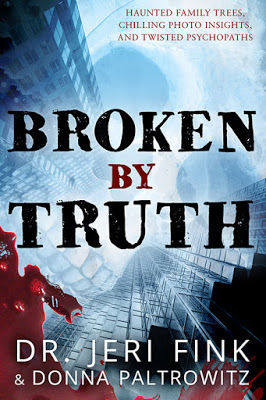
19. DID YOU HAVE YOUR BOOK / BOOKS PROFESSIONALLY EDITED BEFORE PUBLICATION?
Absolutely! Any writer who thinks he or she can edit their own books is missing something. We all need editors – from content to copyediting. Too many Indie writers skip this step with disastrous results.
20. IF YOU WERE STUCK ON A DESERT ISLAND WITH ONE PERSON, WHO WOULD IT BE? WHY?
My husband – as I said above.
21. WHAT WOULD YOU SAY IF YOU HAD THE CHANCE TO SPEAK TO WORLD LEADERS?
Enough hate! Enough politics! Stop looking at money, power, and ego and attend to the real things that affect people – like climate change, peace, and opportunity to live life as they choose. Right now, in my country, the political candidates are arguing about things like immigration and gay marriage. Ridiculous! People have a right to pursue their lives in any way they wish (as long as they don’t hurt anyone or thing). That should be a given. We need to be concerned about preventing wars, terrorists, and most of all, climate change. If everyone could visit the Arctic and see what’s happening, they would know what I mean. Ignoring climate change is like discussing real estate taxes when your house is burning down.
22. WHAT ARE YOUR PLANS FOR THE FUTURE?
When my new series, Broken,is out (I hope before the end of the year), I want to do another series that focuses on New York and it’s very colourful history. I’ll also continue to explore and expand my online presence in blogs, photos, etc. Lastly, I would like to write two mini non-fiction books – one on photo psychology and another on hidden places to visit in New York City.
23. DO YOU SEE YOURSELF IN ANY OF YOUR CHARACTERS?
All of them and none of them.
24. DOES THE PUBLISHING INDUSTRY FRUSTRATE YOU?
Totally. Read #35.
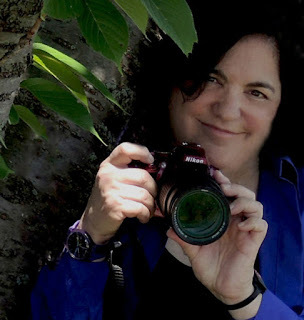
26. DID YOU EVER THINK OF QUITTING?
I tried once – for about a day. It was more like a temper tantrum.
27. WHAT WAS YOUR FAVOURITE MANUSCRIPT TO WRITE? WHY?
I think my favourite book to write and research was the 4thbook in my series of thrillers, Broken By Madness. It’s the first historical in the series and takes place in my favourite place on the planet – New York City. I grew up in New York and have spent my adult life in the suburbs. I discovered a rich mix of history and culture right in my backyard – I still astound native New Yorkers with what I found in plain sight. For example, the world renowned Wall Street was originally a wall built in the 1600s to keep out the Indians and the British. It’s gone now, of course, but if you walk down Wall Street in Manhattan there’s a line of black bricks in the pavement that follows the original wall! In this book I confronted a unique challenge as a family therapist when my characters with psychological disorders couldn’t be defined in modern terms. How do you describe a psychopath in the 1600s?
28. HOW WOULD YOU DEFINE ‘SUCCESS’ AS A WRITER?
Clean writing, well-organized, clear plotting, published, and read.
29. WHAT SHOULD READERS WALK AWAY FROM YOUR BOOKS KNOWING? HOW SHOULD THEY FEEL?
My new books are designed for today’s readers – a good, fast read with strong plot and a lot of action. They’re written so readers, if they want, can go to deeper levels to understand the symbolism, metaphors, emotions, and significance of the content. For example, all of the books in the Broken series, are connected even though they span 500 years. Names, actions, places, and roles link between all the books. However, the reader who doesn’t care can still enjoy each book independently.
30. HOW MUCH THOUGHT GOES INTO DESIGNING A BOOK COVER?
A book cover is critical – one of the most important components of a good book. I work with a professional designer but have constant input.
31. WRITING IS ONE THING. WHAT ABOUT MARKETING YOU, YOUR BOOKS AND YOUR BRAND? ANY THOUGHTS?
Book marketing/branding is up to the author these days unless you’re a #1 bestseller. It’s all about money and how many books are sold. I spend a huge amount of my daily time on this – I write many blogs, photo essays, email lists . . . it’s endless. I consider it a necessary evil.

32. ARE YOUR BOOKS SELF-PUBLISHED?
I’m a hybrid author – I’ve done both traditional and indie publishing.
33. WHAT PISSES YOU OFF MOST?
Let me tell you a story. I co-authored a children’s book about a REAL therapy dog (my dog) named Gizmo who spent his life working with local kids. In the book, Gizmo wanted the world to be clean and safe for everyone. The story went up the ladder – accepted by every acquisition and content editor along the way. They loved it. Ultimately it was rejected. The reason why? They “loved” the book but the main character (Gizmo) wasn’t a famous dog or owned by a celebrity.
Too many books are out there because they’re “written” by celebrities, authors who are young and look good when they go to the “in” parties in town, or look alluring on a book cover. “Real” authors tend to be introverted, thoughtful, and creative – something that’s rarely considered in selecting books to be “bestsellers.”
It’s like asking my Golden Doodle puppy to discuss politics. They’re different beasts.
34. WHAT WOULD MAKE YOU HAPPIER THAN YOU ARE NOW? CARE TO SHARE?
Someone to take care of all my marketing, sales, and business. I enjoy the blogs and photo essays but the other stuff . . .
35. ANYTHING YOU’D LIKE TO ADD?
Thank you for giving me the opportunity to be a guest on your website. One of the greatest things about today’s writing is that so many barriers have come down – we can reach across the world and share our thoughts, ideas, and emotions. I like to brag that my book cover designer is in Taiwan and my website developer is in the Philippines.
I have a son who lives in Israel and I hope, a new friend in Australia. I communicate with a fellow author in South Africa as easily as my friend who lives a few blocks away. The world is a remarkable place and all of us need to participate, in as many ways as possible, preserving it for future generations.
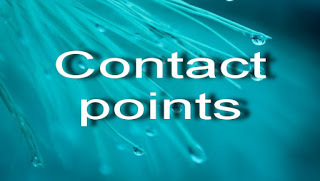
HAUNTED FAMILY TREES
BOOKS

Clancy's comment: Well done, Jeri. Great photographs. Agree with you about writing compared to marketing. Yuk, what a pain, but necessary.
I'm ...

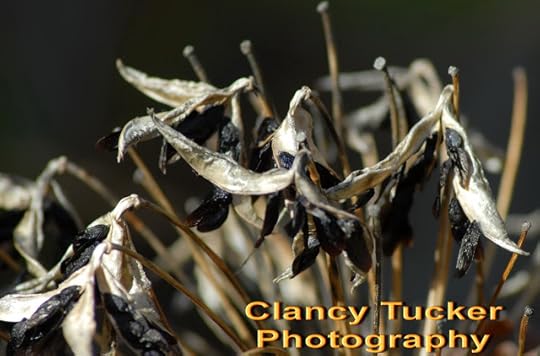
Published on December 14, 2015 02:27
December 13, 2015
14 December 2015 - THE COLOSSUS OF RHODES
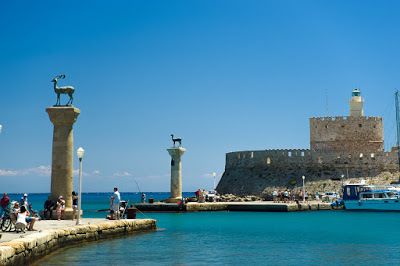
THE COLOSSUS OF RHODES
G'day folks,
Today, I feature something I've featured before. The Colossus of Rhodes /roʊdz/ was a statue of the Greek titan-god of the sun Helios, erected in the city of Rhodes, on the Greek island of the same name, by Chares of Lindos in 280 BC.
Colossus of Rhodes was a gigantic statue of the Greek god Helios, erected on the island of Rhodes, Greece, in the III century AC Cares for the sculptor of Lindos. It is considered one of the Seven Wonders of the Ancient World.
All that is known about this statue is due to the news we have left the ancient writers Polibio Strabo and Pliny, and the chronicles of Constantine VII Byzantine Porfirogéneta, Michael the Syrian and Philo.
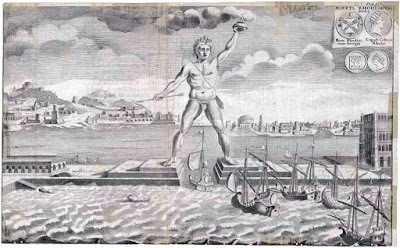
Made with bronze plaques on an iron frame, the statue represented the Greek sun god, Helios. Its size was 32 meters tall and weighs approximately 70 tons, dimensions similar to the Statue of Liberty, located in New York, but rested on a platform lower.
In the year 305 a. C., Rhodes, in the struggles of diádocos was aligned with Ptolemy I, was invaded by an army led by Demetrius Poliorcetes, son of Antigone I Monóftalmos.
To seize the city, built several Demetrio siege towers in order to storm the ramparts. The first of these towers was mounted on six ships. This first attempt did not work because the ship was wrecked in a storm before the tower could be used. Demetrius try again with yet another tower built on higher land. This type of siege weapon was called helepolis. However, the defenders repelled the attack Rhodians flooding the ground before the walls so that the helepolis could not be moved.
In the year 304 a. C. a fleet sent by Ptolemy I, allied with Rhodes, he made haste to flee Demetrio, who left the bulk of its weapons of siege. Despite his failure against the walls of Rhodes, Demetrius Poliorcetes earned the nickname, "conqueror of cities" by his military successes.
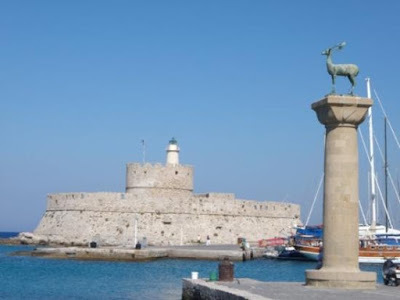
To celebrate their victory, the Rhodians decided to erect a giant statue of the god Helios, the protector of the city. Its construction was commissioned to Cares, a native of the island, which had already made large statues. His teacher, the famous Lysippos, had sculpted a statue of Zeus from 12 meters in height.

56 years after its construction, in the year 223 a. C. an earthquake demolished the colossal work. The inhabitants of Rhodes decided to leave his remains in the same place where the plan fell further to an oracle. And so were the remains of the statue for about nine years, until in the year 654 AD Muslims took over the bronze as the spoils in a number of raids.
For many years it was believed that the statue had been erected with one leg supported on each side of the dock in Rhodes as it appears in some images. However, there appears to have been true for two reasons: If it had been erected there, was sunk by its own weight. The other reason is that its construction would have closed a major spring military for several years, remain vulnerable to attacks by sea. It is believed that the statue was erected near the pier, which is now the fortress of San Nicolas.

With this work the wonders of the ancient world that could be considered in the face of the earth at the same time reached a total of five. This number was never exceeded.
November 2008: According to the current mayor of Rhodes, Hatzis Hatziefthimiou, has instructed the German artist Gert Hof reconstruction of the statue at its former location. That statue, from an initial 200 million, measured between 60 and 100 m. (the original measured about 30 m) and various trade organizations responsible for international finance. According to the artist, the new statue, may be covered by its interior by visitors.

Clancy's comment: There ya go, folks. I still shake my head when I see constructions built so long ago.
I'm ...

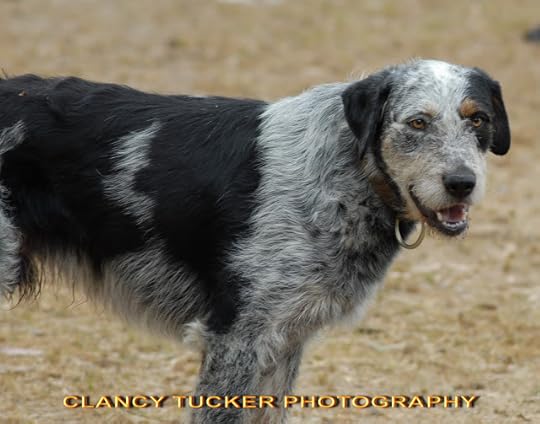
Published on December 13, 2015 01:52
December 12, 2015
13 December 2015 - GREAT WISDOM

GREAT WISDOM
G'day folks,
Welcome to some more wise comments and a bit of humour.

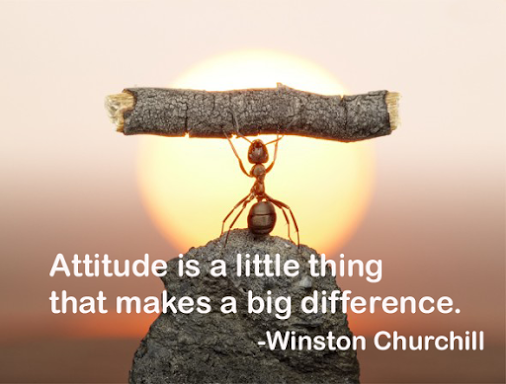





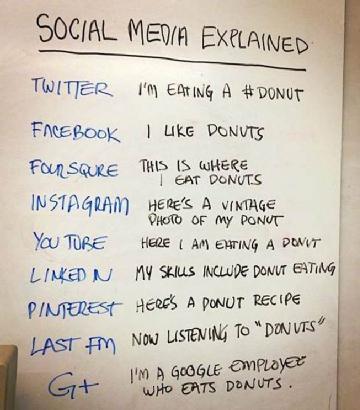
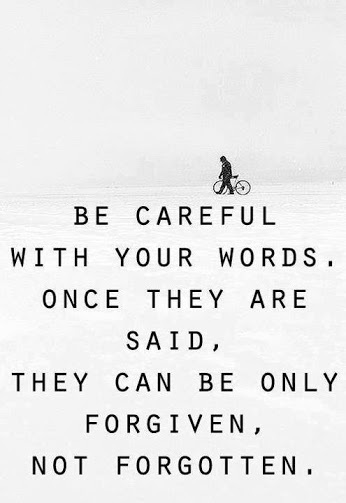









Clancy's comment: Some more good quips here. Hope you enjoyed.
I'm ...

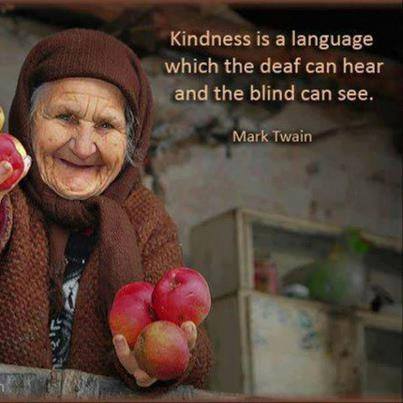
Published on December 12, 2015 04:14
December 11, 2015
12 December 2015 - LIVE AID 30th ANNIVERSARY

LIVE AID 30th ANNIVERSARY
G'day folks,
Live Aid was staged on Saturday, July 13, 1985. About 75 different acts performed live for about 170,000 people in London and Philadelphia. Meanwhile, an estimated 1.5 billion people in 110 countries watched it via a live television stream from 13 satellites. More than 40 nations also held telethons for African famine relief during the broadcast.
In our current digital age, these numbers may seem quaint, but in 1985, there was no World Wide Web, no email, no live blogging and no Twitter. Most people still listened to music by listening to the radio or playing vinyl records and cassette tapes; compact discs (CDs) only became widely available this same year.

The event was a spectacular success, though not without its problems. Satellite links between London and Philadelphia failed several times. But in an ultimate triumph of technology and good will, the event raised more than $125 million in famine relief for Africa.
Origins: Band Aid and USA for Africa
Live Aid was the brainchild of Bob Geldof, the singer of Irish rock group the Boomtown Rats, whose biggest hit was “I Don’t Like Mondays.” In 1984, news reports of a horrific famine that had killed hundreds of thousands of Ethiopians and threatened to kill millions more prompted Geldof to travel to Ethiopia. Upon returning to London, he gathered some of the United Kingdom’s top pop artists Culture Club, Duran Duran, Phil Collins, U2, Wham!, and others to form Band Aid.
Released on December 3, 1984, “Do They Know It’s Christmas?” written by Geldof and Ultravox singer Midge Ure and performed by Band Aid was the best-selling single in the U.K. to that date. Its proceeds raised more than $10 million for Ethiopian famine relief. Also a No. 1 hit in the United States, the song inspired U.S. pop artists to come together.

On January 28, 1985, USA for Africa recorded “We Are the World,” a song written by Michael Jackson and Lionel Ritchie. Producer Quincy Jones organized the U.S. ensemble, which featured Jackson, Ritchie, Geldof, Harry Belafonte, Bob Dylan, Cyndi Lauper, Paul Simon, Bruce Springsteen, Tina Turner, Stevie Wonder, and many others. That single eventually raised $44 million for famine relief.
An Ambitious Event
As the famine continued in Ethiopia and spread to neighboring Sudan, Geldof proposed Live Aid, a dual charity concert aimed at raising more funds and increasing awareness of the plight of many Africans. Organized in just 10 weeks, Live Aid was nothing if not ambitious. The event consisted of two concerts, one in London’s Wembley Stadium and the other in Philadelphia’s JFK Stadium, which ran almost simultaneously. While one show took a break to change sets and equipment, the other featured an act that kept television audiences glued to the screen and, it was hoped, not far from their phones.
Around midday (London time) on July 13, 1985, Prince Charles and Princess Diana officially kicked off Live Aid and an unprecedented 75 artists performed, sometimes joining each other onstage. Continuing on at JFK Stadium in Philadelphia, the “super concert” clocked in at 16 hours.
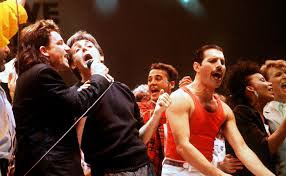
Concert Highlights
Phil Collins performed at Wembley concert and then memorably boarded the turbojet-powered supersonic passenger jet the Concorde, which delivered him to Philadelphia where he performed again. Later in the show, he filled in for the late John Bonham to play drums in a reunion of the surviving members of Led Zeppelin.
The London bill included the Boomtown Rats, Adam Ant, Elvis Costello, Sade, Sting, Bryan Ferry, U2, Dire Straits, Queen, David Bowie, The Who, Elton John, and Paul McCartney. Being included in the event was a big break for U2 and Bono famously made the most of it by pulling 15-year-old Kal Khalique out of the audience slow dancing with her (for about 20 seconds) as the band played on.
Musically, the critics seemed to concur that Queen stole the show as the band had never sounded better.
Over in Philadelphia, performers included Joan Baez, The Four Tops, Black Sabbath, Run DMC, Crosby, Stills and Nash, Judas Priest, Bryan Adams, Beach Boys, George Thorogood & the Destroyers (also with Bo Diddley & Albert Collins), Simple Minds, The Pretenders, Santana (also with Pat Metheny), Ashford & Simpson with Teddy Pendergrass, Madonna, Tom Petty, Neil Young, Eric Clapton, Robert Plant, Duran Duran, Patti LaBelle, Mick Jagger (also with Tina Turner), Bob Dylan, Keith Richards and Ron Wood. Beatle Paul McCartney and The Who’s Pete Townsend held Bob Geldof aloft on their shoulders during the London finale, which featured a collective performance of “Do They Know It’s Christmas?” Six hours later, the U.S. concert ended with “We Are the World.”
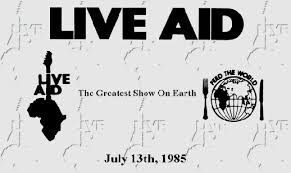
Live Aid’s Legacy: Live 8 and Beyond
The funds Live Aid raised and the publicity it generated encouraged Western nations to make available enough surplus grain to end the immediate hunger crisis in Africa. Queen Elizabeth II later knighted Geldof for his efforts and he has remained a committed activist.
In early July 2005, Geldof staged a series of “Live 8″ concerts in 11 countries to help raise awareness of global poverty. It was purposely scheduled days before the annual G8 summit in an effort to increase political pressure on G8 nations to address issues facing the extremely poor around the world. An estimated 3 billion people watched 1,000 musicians perform in 11 shows, which were broadcast on 182 television networks and by 2,000 radio stations.
Unlike Live Aid, Live 8 was not billed as a fundraiser. Geldof’s slogan was, “We don’t want your money; we want your voice.” Perhaps in part because of the spotlight brought to such issues by Live 8, the G8 subsequently voted to cancel the debt of 18 of the world’s poorest nations, make AIDS drugs more accessible, and double levels of annual aid to Africa, to $50 billion by 2010.
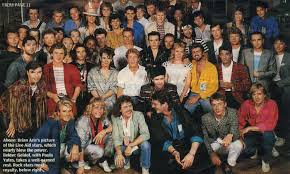
Geldof has said he sees “no political logic” to staging such another Live Aid but Band Aid (this time featuring Chris Martin of Coldplay, Elbow, Foals, Sinead O’Connor and Bono) did release a new version of “Do They Know It’s Christmas” with updated lyrics in November 2014. Proceeds from its sales will go toward fighting against Ebola in Africa.
Now, check out the famous song that joined millions of folks and rock stars.

DO THEY KNOW IT'S CHRISTMAS
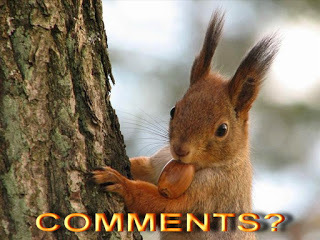
Clancy's comment: This event was one of the highlights of my life. Love the song! The star list is massive. Just shows what can be achieved when people get together for a good cause.
I'm ...

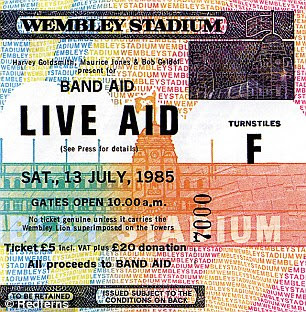
Published on December 11, 2015 05:47



